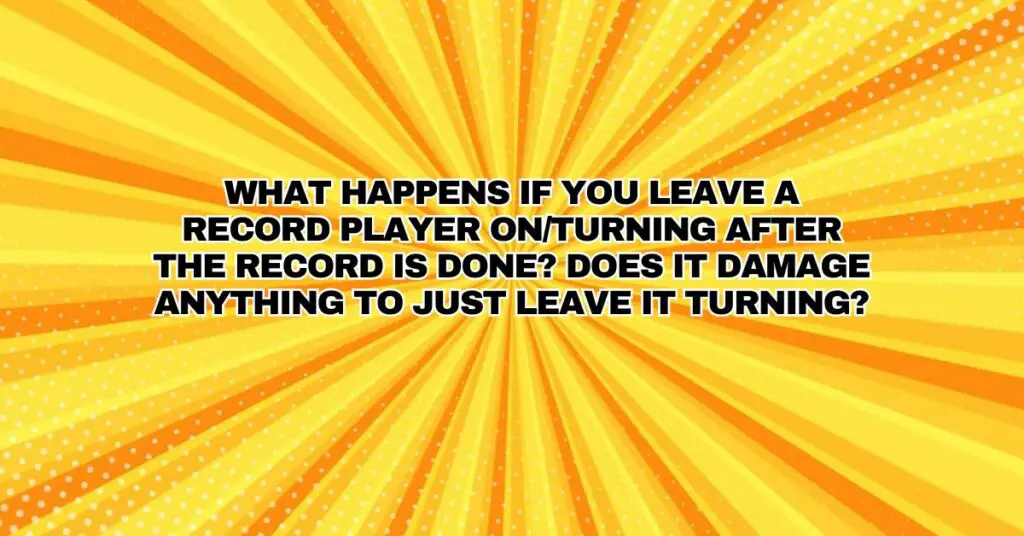Vinyl records, known for their warm analog sound and tactile appeal, have seen a resurgence in popularity among audiophiles and music enthusiasts. The experience of placing a vinyl record on a turntable, lowering the stylus, and immersing oneself in the music is a cherished ritual. However, the question of what happens when you leave a record player on or turning after the record has finished playing is a common concern. In this comprehensive guide, we’ll explore the potential consequences of extended playback and discuss whether leaving a record player on can cause any damage.
The Anatomy of a Record Player
Before delving into the impact of leaving a record player on, it’s essential to understand the fundamental components that make up a record player:
- Platter: The rotating platform where the vinyl record is placed during playback.
- Tonearm: The arm that holds the cartridge and stylus (needle), which tracks the grooves on the record.
- Cartridge: The device responsible for converting the physical vibrations from the grooves into electrical signals.
- Turntable Motor: The component responsible for spinning the platter at a specific speed, allowing the stylus to trace the grooves.
- Drive System: Turntables can be either belt-driven or direct-drive, each affecting the longevity of the system.
Leaving a Record Player On: Potential Consequences
Leaving a record player on, especially if it’s still turning without a record playing, can have several potential consequences. Let’s examine them in detail:
- Stylus Wear: Continuous spinning without a record playing places unnecessary wear and tear on the stylus (needle). The stylus may rub against the platter or slipmat, leading to accelerated deterioration and a shorter lifespan.
- Motor Stress: The motor that drives the platter and tonearm can experience stress if left running for extended periods. This continuous operation may result in motor fatigue, overheating, or decreased longevity.
- Energy Consumption: Keeping your record player on consumes electrical power, which is both wasteful and may result in higher energy bills.
- Dust Accumulation: Extended operation increases the exposure of your turntable to dust and debris in the environment. Dust can accumulate on the stylus, cartridge, and other components, potentially degrading audio quality and causing tracking issues.
- Overheating: Some record players may be prone to overheating if left running for an extended period. Overheating can lead to performance issues and, in some cases, damage to the components.
Preventive Measures and Best Practices
To avoid potential consequences and damage when using a record player, consider the following preventive measures and best practices:
- Turn It Off:
- Turn off your record player when you’re not actively using it. This practice saves energy and prevents unnecessary wear on the stylus and motor.
- Cleanliness:
- Keep your turntable and vinyl records clean. Regular maintenance, such as stylus cleaning and dusting, helps ensure optimal audio quality.
- Proper Storage:
- Store your vinyl records vertically in protective sleeves to prevent dust and maintain their condition.
- Scheduled Breaks:
- If you’re planning a long listening session, consider periodic breaks to allow the record player to rest and cool down.
- Maintenance:
- Regularly inspect and maintain your record player, ensuring that components are in good condition and functioning correctly.
- Invest in Quality:
- Invest in a high-quality turntable with features like auto-stop or auto-return, which can help preserve the stylus and prevent continuous operation.
In Conclusion: Use with Care
Leaving a record player on or turning continuously after the record has finished playing is not advisable. It can lead to unnecessary wear and tear on components like the stylus and motor, increase energy consumption, and expose the turntable to dust and overheating. To enjoy your vinyl records while preserving the longevity and performance of your turntable, adopt responsible practices that include regular maintenance, scheduled breaks, and proper storage. With care and attention, your record player can continue to provide the distinctive, analog sound and tactile experience that vinyl records offer.


